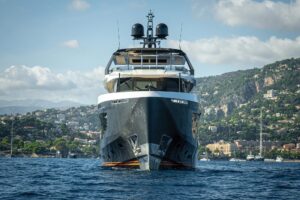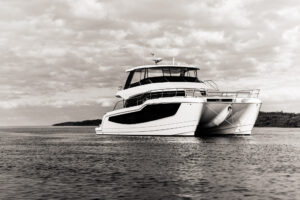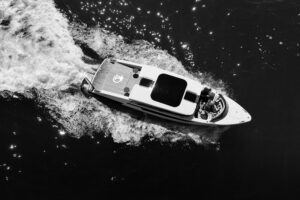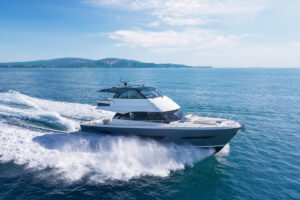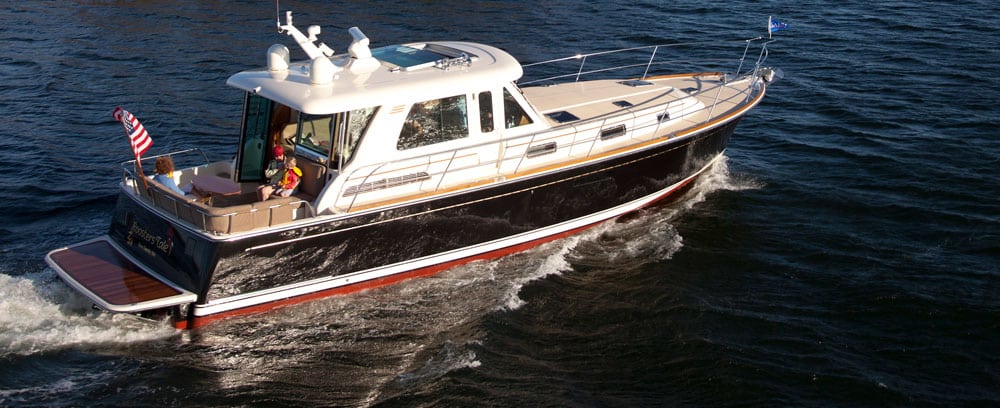
Sabre 48
I need to come clean: I no longer embrace the opportunity to test a new boat with the same vigor and unbridled enthusiasm I did 10 years ago. Don’t get me wrong — I love running boats, but admittedly the thrill has diminished slightly over the course of time. This is partly due to the fact that the majority of boats we run today are fairly predictable, which isn’t necessarily a bad thing. Allow me to explain.
At last count, I had more than 125 tests under my belt. Some were memorable and some not so much. And some were memorable for being, well, not so memorable. Years back there were a few boats that did not hold up to our standards, and thus never made it into the pages of this magazine. There was the express cruiser that sank in its slip an hour before my sea trial — making it fairly difficult to complete a full evaluation. There was the boat that leaned out of its turn, and kept leaning, leaning and leaning, prompting the marketing manager to whisper “uh-oh” while edging toward the only PFD on board. And then there was the express cruiser that would require Shaq to stretch his toes while standing on a ladder to see over the bow from the helm. (The builder suggested adding an optional $2,000 video camera on the bow pulpit to avoid running over a cruise ship while under way.)
Yet today, with all of the advancements in design technology, precision mold machines and tank testing, a builder has to work fairly hard at creating a bad design. (Of course, there is a varying degree of quality in build processes.)
Then a boat, like the Sabre 48, comes along that causes me to stand at attention — a boat that tramples on the formula of predictability and reminds a jaded boat-tester like myself that running boats can still be thrilling (watch the video and see the gallery, too).
Sabre practices an “evolutionary versus revolutionary” design philosophy, according to Bentley Collins, Sabre’s vice president of marketing and sales. Every new model relies on a strong, classical pedigree, displaying a family resemblance throughout the line. Yet, take a look at a 10-year-old Sabre and compare it with this 48, and it’s obvious that the designers and engineers are not simply spitting out more of the same.
Sabre is one of the masters of building classically inspired Down East designs that incorporate modern styling details. Combined as a whole package, these details create a timeless, elegant, yet contemporary design. The proportions of the 48 work perfectly, in my opinion. The tumblehome of the transom flows seamlessly into a deck with moderate sheer, which benefits from a cabin house design that is absent of any harsh 90-degree angles. The rake of the after portion of the house flows into the vertical strut of the upper deckhouse, which is accented by the engine room vents that carry the same angle — Brooks Brothers meets Giorgio Armani.
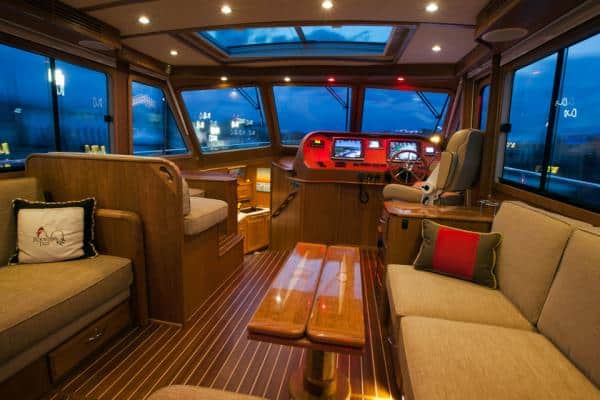
The cockpit was another welcome surprise. Many traditional builders don’t put as much effort into cockpit seating comfort as builders of more Euro-inspired designs. It’s as if some Yankee boatbuilders feel the need to embrace their Puritan roots — a group of people so uptight that even the British told them to take a hike. The one-level arrangement of the 48’s cockpit works extremely well for entertaining and allows for a seamless transition from the swim platform to the salon. A stainless-steel safety rail surrounds the aft three-quarters of the cockpit for additional security. An L-shape settee across the transom hugs a teak table and faces a bench settee across the aft bulkhead, allowing for a natural conversation pit at anchor or under way. This is where I would plant myself with a cup of coffee and the morning paper while on the mooring in a secluded cove. Our test boat featured an optional teak deck in the cockpit for a little extra security under foot. Sabre also offers a FreedomLift tender system on the platform to ensure that launching and retrieval are hassle-free.
Walking forward I was reminded of Sabre’s 40-year cruising pedigree. The decks are wide, the molded nonskid will grip your feet, and the stainless rails are at the perfect height. It was also refreshing to find a dual anchor roller — a must-have on a cruising boat, in my opinion. Two large bow lockers absorb fenders and lines.
Another smart touch was the starboard opening door next to the interior helm. Would the side profile be a little cleaner without it? You bet. However, I like Sabre’s lean toward functionality. This door is especially convenient for cruising couples, allowing the helmsman to easily step out to secure a spring line. The benefit of a fresh breeze blowing into the salon can’t be discounted.
The other entrance to the salon is through the stainless-steel door in the cockpit. The adjacent aft-facing window drops away to join the interior with the cockpit area. In fact, Sabre does a superb job of creating the feeling of an open express boat within the design parameters of a “salon express.” With the optional sunroof opened and the aft window lowered, there will be plenty of breeze flying, saltwater aroma and a connection with the outdoors. Sabre’s in-house naval architect, Kevin Burns, also placed extra emphasis on creating unobstructed sight lines throughout the salon — it really paid off. Even when seated at the L-shape settee abaft the helm, I was able to take in the sights of Portland, Maine, during our sea trial.
“One of the things that’s nice about this style of boat is that on a day like this you can still go out and have a nice day on the water,” commented Collins, referring to the chilly, gray overcast day of our sea trial. Indeed, we remained warm inside with plenty of places to sit back and simply enjoy being on the water. (Boaters in the Pacific Northwest, take note.)
The helm is another area that reveals Sabre’s combination of classic and contemporary styling. A leather-wrapped, curvy helm housed the two Garmin displays and Cummins electronic engine gauges. Leaning against the standard Stidd helm seat, I had a nearly unobstructed, 360-degree line of sight. It was nice to see an Exalto wiper on the center window in addition to the ones on the outboard windows. I’m constantly amazed at the number of builders that skimp on that vital center wiper. It’s these types of details, along with items such as the double anchor roller, side door, loads of stowage and wide decks that ensure that the Sabre 48 is more than just a pretty face.
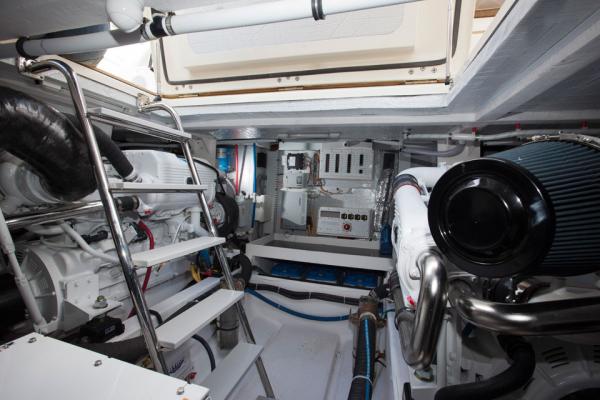
Our test boat was fitted with a pair of 550-horsepower Cummins QSC 8.3 diesels coupled to Zeus pod-drives. At speed, the moderate V-hull has a stable and secure feel that I’ve come to expect from each Sabre. Burns altered the bottom and pod angle slightly in order to bring the bow down and create an optimum running angle throughout the speed curve. We shot out of the hole like a bucking bronco and reached a top speed of 34 knots, running at approximately 3.5 degrees. At 2,700 rpm I recorded a high cruise of 30.2 knots. Most remarkably, we registered a total fuel burn of 44.7 gallons, which gives the 48 a range of approximately 315 miles with a 10 percent reserve. That’s damn efficient.
Sitting on the Stidd, surrounded by warm cherry joinery and expertly stitched leather, the sportiness of the 48’s handling was a striking contrast to what you might reasonably expect of a typical Down East cruiser. Yet after five pod-drive models, it’s become standard fare for this builder. The response to adjustments of the wheel is instant, and only a minimal amount of speed is lost when turned hard over.
“This is our first model where we also designed the interior around the pods,” Collins noted, before unveiling a surprise in the salon. With a touch of a button, the portside settee moved inboard, revealing a bonus space beneath the sole in an area typically reserved for the engines. On our test boat, the space was finished as a stateroom designed to host the owner’s grandkids. With headroom of 5 feet 10 inches, a little stooping may be required, but the berth and head will certainly provide comfortable accommodations for kids or adults. Owners can also forego this option and create a utility room with a washer and dryer, additional stowage and even a freezer for the long-distance cruiser.
The rest of the accommodations truly reflect Sabre’s evolutionary design process. Details such as ceramic tile with glass tile accents in the heads, Shoji screens in the master stateroom and elegantly detailed joinery create an extremely comforting atmosphere. The amount of interior stowage was impressive, highlighted by five deep drawers and a hanging locker in the master. An island berth in the forward, en suite guest stateroom complements the athwartship berth in the master. I’ve seen many boats of this type and size where the master stateroom pales in comparison to the 48’s guest accommodations.
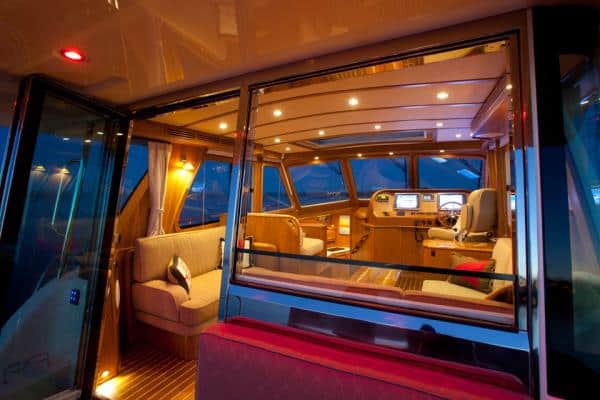
The fully equipped galley lines the port side and will please the demanding gourmet with double sinks, Isotherm refrigerator and freezer, a microwave/convection oven and an area for an optional dishwasher.
Even with such voluminous accommodations, the 48’s machinery space is large. An access hatch in the cockpit allows for easy inspections and fluid checks, and all components are neatly displayed and serviceable. The 11.5 kW generator sits on the centerline, while the fuel tanks are positioned outboard on each side, forward of the engine room.
Sabre’s continued dedication to innovation and quality made this boat a thrill to drive, and it will certainly be more of a thrill to own. I admit, I’m actually looking forward to my ride on the company’s new 54 later this fall.
Watch the video and see the complete photo gallery of the Sabre 48.
LOA: 47’6″
BEAM: 15’4″
DRAFT: 3’9″
DISPL.: 34,700 lb.
FUEL: 500 gal.
WATER: 160 gal.
DEADRISE: 14 degrees
at transom
ENGINES TESTED: 2 x 550 hp Cummins QSC 8.3 diesels with
Zeus pod-drives
BASE PRICE: $920,000
PRICE AS TESTED: $1,100,000
RPM Knots GPH dB(A)
900 7.1 3.2 64
1200 8.8 7.0 67
1500 10.2 13.5 69
1800 14.7 23.1 71
2100 20.4 29.9 74
2400 25.9 36.2 75
2700 30.2 44.7 75
3000 34.0 59.7 77
Sabre, 207-655-3831; www.sabreyachts.com

